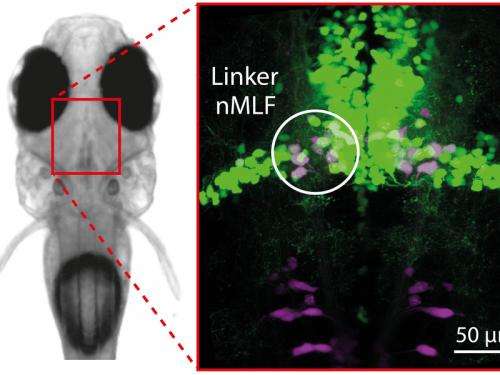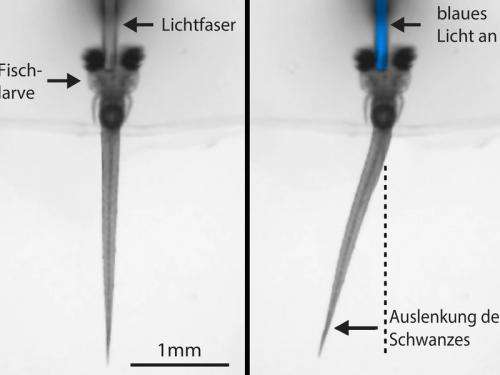A small group of nerve cells in the fish brain control swim posture

For a fish to swim forward, the nerve cells, or neurons, in its brain and spine have to control the swishing movements of its tail with very close coordination. However, the posture of the tail, which determines swimming direction somewhat like a rudder, also needs to be fine-tuned by the brain's activity. Using the innovative method of optogenetics, scientists from the Max Planck Institute of Neurobiology in Martinsried have now identified a group of only about 15 nerve cells which steer the movements of the tail fin. Movements of the human body are also controlled via nerve pathways in the same region of the brain, which may therefore use processing mechanisms similar to those in fish.
For a long time, neurobiologists have been trying to find out how neuronal networks control both animal and human behaviour. In this context, there is controversy as to whether the brain's organisation is decentralised as opposed to modular. In decentralised organisation, the interaction of a large number of neurons produces a specific behaviour pattern. If this is the case, individual neurons cannot be assigned an exact function. On the other hand, if the brain has a modular structure, individual regions might possess certain competencies, each making a specific contribution to behaviour. These types of neuronal circuit modules could be combined in many ways and influence a broad range of different behavioural responses.
Switches in the fish brain?
Researchers in Herwig Baier's Group at the Max Planck Institute of Neurobiology want to get to the bottom of the brain's organisational structure with the aid of zebrafish larvae. A network known as the descending reticular formation is located in the brainstem of these animals. The neurons of that region are optimally suited for studying the organisation of the brain: the cells are in direct contact with motor neurons in the spinal cord of the fish and can thus directly influence tail movements. "The reticular formation is a like a 'cockpit' for the fish, and we asked ourselves whether there are individual 'switches' or 'joysticks', which are used to control the movements of the tail", is how Herwig Baier summarises this challenge.

In their search for these switches, the researchers concentrated on a small brain nucleus (nMLF) within the reticular formation. But how can the influence of individual nMLF neurons on tail movements be studied? It is only recently that such investigations even became a possibility. Using the new method of optogenetics, the activity of nerve cells can be influenced with light. Since a zebrafish larva – including its brain – is transparent, scientists can very accurately "switch on" small sets of genetically modified cells by exposing the larva to blue light. Consequently, tail movements that are induced in this way can be attributed to identified neurons.
Neurons and tillers
The first series of tests showed that the cells of the nMLF region seem to be involved in a variety of movements – from forward propulsion to rotational motion. A second experimental series using optogenetic stimulation, however, suggested that the cells control the deflection of the tail in particular. Are the nMLF cells thus part of a multifunctional centre or are they truly specialised to perform certain functions? To resolve this question, the neurobiologists performed another set of trials in which they very specifically removed small sets of nMLF cells from the circuit. "This experiment gave us our breakthrough", recalls Tod Thiele, lead author of the now published study.
The results show that, while nMLF cells are active in many aspects of swimming, a subset of these neurons contribute to only one part of the movement: they determine swimming direction through the posture of the tail. Thus, this population of neurons in the nMLF region are more akin to a specialised module within a decentralised control system of the swimming apparatus. Herwig Baier explains it like this: "We can compare the whole setup with the propulsion of a motorboat". The boat's engine, which drives the propeller, determines the thrust, whereas the tiller steers the boat. It seems that the tasks in the brain are divided up in a very similar way.
Some time ago, Herwig Baier's team discovered a small region in the hindbrain, which acts like an engine and propels the fish forwards. "With the nMLF cells, we have now also found the tiller in the fish brain", says Herwig Baier. In the human brain, movements are also controlled by a multitude of nuclei in the reticular formation. The study therefore suggests that the allocation of tasks in our brain could be similar to that of the zebrafish.
More information: Tod R. Thiele, Joseph C. Donovan, Herwig Baier, "Descending Control of Swim Posture by a Midbrain Nucleus in Zebrafish," Neuron, Available online 24 July 2014, ISSN 0896-6273, DOI: 10.1016/j.neuron.2014.04.018.




















